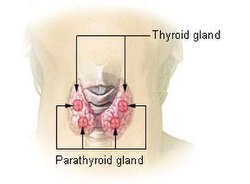Parathyroid glands
The parathyroid glands (lat. glandulae parathyreoideae) are four small, lens-like formations on the back of the thyroid glands, enclosed in its capsule. They develop from the entoderm of the 3rd and 4th gill slits. Each corpuscle is enveloped by a capsule of collagenous tissue, from which thin septa depart, which increase in size with increasing age by the accumulation of adipocytes. The parenchyma is arranged in a trabecular epithelium, in which we find chief cells and oxyphilic cells.
Microscopic Structure
Chief cells
They represent the predominant element in the gland. These are polyhedral cells with spherical nuclei and light-staining cytoplasm with a diameter of 10 μm. They contain secretory granules exhibiting argyrophilic properties (they are impregnable with salts of heavy metals – Ag, Au). These cells produce parathormone, which increases the level of calcium ions in the blood by increasing bone resorption and reabsorption in the kidney, and secondarily by stimulating hydroxylation of 25-hydrocholecalciferol in the kidney at position 1. This creates 1,25-dihydrocholecalciferol (calcitriol) increasing the absorption of calcium in the intestine.
Oxyphilic cells
Polyhedral cells larger in size than the chief cells, their nuclei are relatively brightly colored. In the cytoplasm we find a large number of mitochondria (they condition its strong eosinophilia), glycogen granules, but no secretory granules. The cells appear postnatally, around the age of 10.



